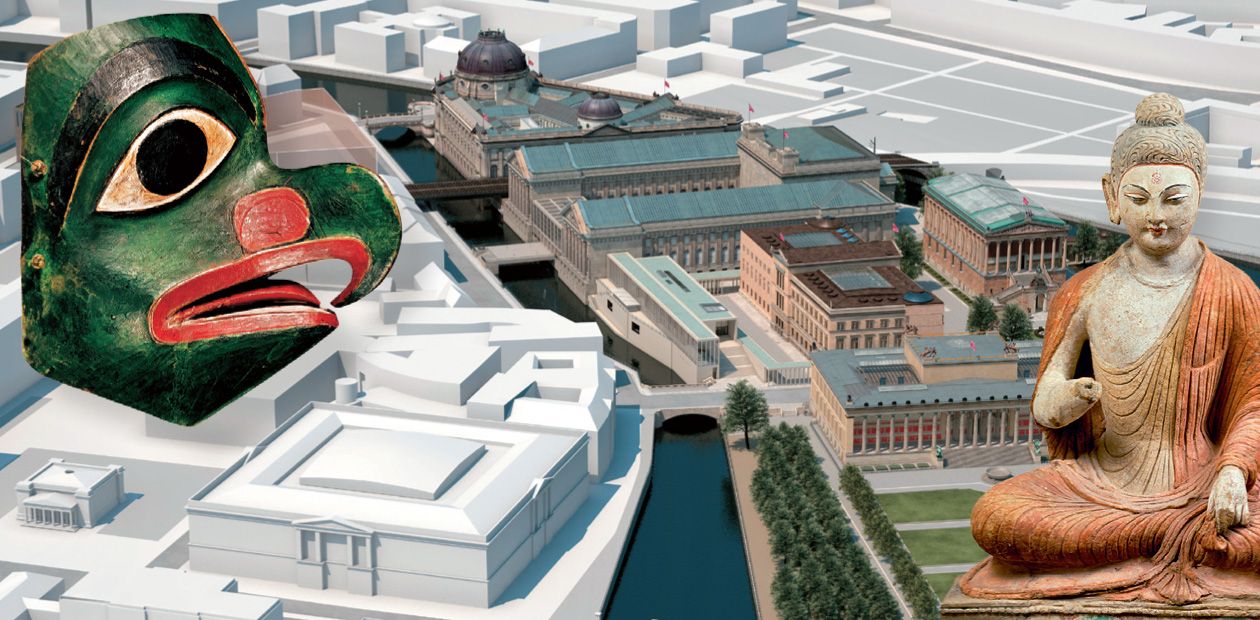Museum Island and Humboldt-Forum
A New Centre for Art and Culture in Berlin
The Prussian Cultural Heritage Foundation is by far the largest cultural institution in Germany and one of the largest of its kind in the world. It emerged from the cultural institutions of the former State of Prussia, which was dissolved after the end of World War II. Today, the responsibility for maintaining the Prussian Cultural Heritage Foundation rests both with the Federal Government and with all sixteen federal states of Germany. The Prussian Cultural Heritage Foundation is the only cultural institution in Germany that is maintained by both the Federal Government and by all sixteen states despite the cultural sovereignty of the latter, which is due to the Foundation’s particular national importance. Today, we present a grand project aimed at reorganizing Berlin’s cultural and artistic centre. It includes the restoration and modernization of the famous Museum Island, whose architectural complex became a UNESCO World Heritage Site in 1999
The Prussian Cultural Heritage Foundation includes the sixteen State Museums of Berlin with their outstanding collections covering art and cultural development from the Stone Age to the present. In addition, the National Library of Berlin with its two buildings located on Unter den Linden and on Potsdamer Strasse is part of the Foundation. Comprising more than eleven million volumes, it is one of the largest universal academic libraries in the whole German-speaking world. The Prussian State Archive is the third institution of the Foundation; thirty-eight kilometres of files and documents on Prussian and German history are kept in this archive, where they are accessible for research.
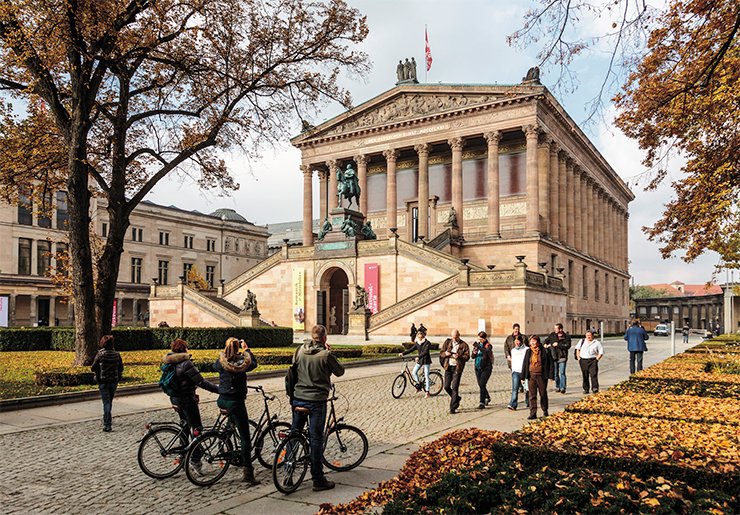
The Ibero-American Institute is one of the largest research institutions of its kind outside the Ibero-American world and has one of the most comprehensive libraries. Last but not least, the National Institute for Music Research with the Museum of Musical Instruments is the fifth institution of the Foundation. Hence, it can be said that the Prussian Cultural Heritage Foundation comprises all branches of cultural tradition, ranging from art and material culture to literature, documents, and music. This can be regarded as a unique characteristic of the Foundation, because in many other countries national museums, national libraries and national archives are separate institutions independent of each other whereas in Berlin they find themselves under one umbrella due to their Prussian origin.
One of the most prominent tasks of the Prussian Cultural Heritage Foundation is the development of the historical centre of Berlin. This comprehensive task includes two components, that is, reconstruction or rebuilding, and the addition of new building units in order to optimize access to the cultural heritage kept in these institutions, both for research and for meeting the needs of the culturally interested public.
The Berlin acropolis
Halfway between the Brandenburg Gate and Museum Island, on the left, is the historical building of the Berlin National Library, which was opened to the public in 1914. It was one of the most important and largest library buildings of its time, but it suffered massive destruction in the course of heavy air raids on Berlin during World War II. Particular damage was done to the spacious reading room, which was topped by a 35-meter-high cupola. For more than ten years, an ambitious restoration project has been going on: the historical structure of the building has been modernized and preserved, while at the same time a completely new public reading hall has been added. The National Library on Unter den Linden is a good example of the optimal renovation and restoration of a historical structure, and the replacement of destroyed parts with modern architectural elements; it is also equipped with the most modern and innovative research and digitization infrastructure.
A bit further eastwards is the Museum Island, which spreads out onto the plain of the Spree River like an acropolis of knowledge and art. The development of the Museum Island began with the so-called Old Museum, built by Schinkel, which was opened in 1830. The head of the museum commission was Wilhelm von Humboldt, who insisted that the works of art—both sculptures from antiquity and paintings and drawings of Old Masters—had to be exhibited without any chronological, cultural or other contextualization. The Prussian King Friedrich Wilhelm IV came to envision the Museum Island as a complex of several separate museum buildings which, since then, has been called an open space for arts and sciences. While other large universal museums in the world attempt to accommodate the legacies of different epochs and cultural regions in separate wings and storeys of one and the same building (the Louvre, British Museum, and Metropolitan Museum of Art), the Museum Island was based on a different concept from the very beginning. Importance was attached to giving each cultural region and each art genre a building of its own, with every building also representing a particular stage of museum history in the one hundred years of the Museum Island’s existence.
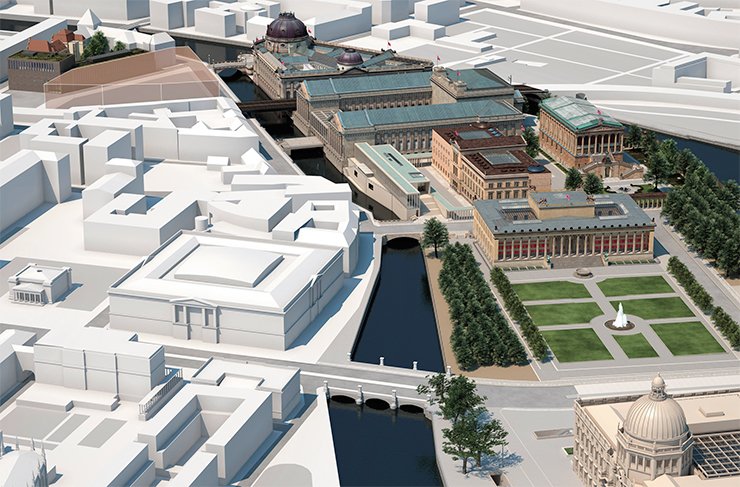
During World War II all buildings of the Museum Island were damaged. However, it was possible to modernize and restore most of them, except the so-called New Museum, built by Stüler. Nevertheless, the realization of the so-called ‘Museum Island Master Plan’ began in the late 1990s. It involves a complete overhaul of all buildings, the first-time restoration of the New Museum and the addition of new buildings, such as the James Simon Gallery as a new entrance building of the Museum Island.
The first building of the Museum Island to be restored was the Old National Gallery, which was reopened in 2001 in its former Wilhelminian splendour and has, since then, been regarded as an outstanding museum for 19th-century painting and sculpture. The second building to be restored was the Bode Museum. Completed in 2006, it is a marvellous neo-renaissance building that, just like the Old National Gallery, re-emerged in its old splendour. Today it comprises the collections of the Museum of Byzantine Art and of the Sculpture collection, thus giving an excellent overview of the history of sculpture from late antiquity to the 18th century.
In 2009, the New Museum was reopened after its heavy destruction by an air attack on Berlin in 1944. Prior to the restoration it had stood in Museum Island as a ruin for almost seventy years because it had suffered the worst damages: more than one third of its entire structure was completely destroyed. The concept pursued by David Chipperfield in restoring the New Museum included the preservation of all structure elements and of the interior design that had survived from the time of Stüler, as well as addition of new architecture that would blend in harmoniously with the historical structures while at the same time clearly contrasting with them. The result was a new masterpiece of architecture.
The restoration of the New Museum resembled a large research project. Each surviving wall of individual rooms was carefully documented. Then, a team consisting of architects, building historians, archaeologists, conservators, and other specialists developed suitable concepts of restoring each room. At the same time, many rooms in the New Museum reflect museum history. This becomes particularly apparent in the so-called Mythological Hall. The opulent decoration of the ceiling and walls, dating from the middle of the 19th century, was meant to put visitors into the mood for the Egyptian antiquities. In the 1930s, however, the rich design was gradually reduced; there was a first move towards museum education, and the hall was supplied with geographical maps and chronological schemata of culture development. Today, it is still possible to reconstruct these layers of superimposed concepts of museum presentation in several halls of the museum.
Of particular importance is the so-called Egyptian Courtyard, the northern of the two inner courtyards, which was completely destroyed during World War II. Following David Chipperfield’s concept, the level of the inner courtyard was lifted from the ground floor to the first floor. As a result, it looks as if it were floating. At this level the portraits of the royal family of Amarna are exhibited—Akhenaton, Nefertiti, and their daughters. The interplay of daytime sunlight and night-time artificial spotlight shining through the glass roof is a vivid allusion to the Amarna period, a short-lived stage of ancient Egyptian history: it lasted for only seventeen years, during which polytheism was abolished in favour of the exclusive worship of the sun god Amun.
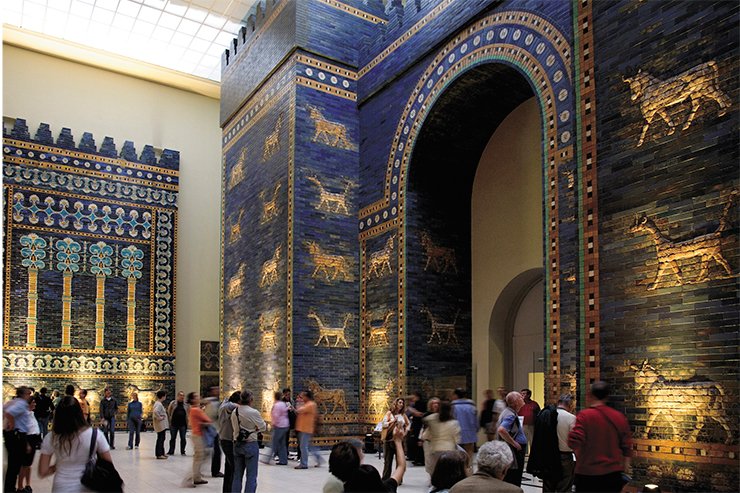
The James Simon Gallery—a new central entrance building of the Museum Island—is currently under construction. Offering central guidance to the visitors and including such infrastructure elements as cloakrooms, museum shops, and cafes, it has all practical, functional amenities needed in a modern museum complex that attracts several million visitors every year. All buildings in the Museum Island go back to the 19th and early 20th century. The original plans did not—and could not—take into account the needs of modern museum tourism. In this respect the James Simon Gallery is an important addition to the Museum Island; it can be considered as the present-day continuation of building activities on this UNESCO World Heritage site, which takes it to the 21st century. Seizing Stüler’s motif of the colonnades that surround the New Museum and the Old National Gallery from the east and from the south, the architect David Chipperfield extends them—translated into a modern design—to the west, where they merge with the James Simon Gallery through a large flight of stairs. In addition, the semi-basement of the James Simon Gallery will have space for special exhibitions. This is crucially important, because all museums of the Museum Island are completely filled with their own collections and do not offer any possibilities for temporary exhibitions; these possibilities will be provided in the James Simon Gallery.
The restoration of the Pergamon Museum began in January 2013. It will take at least thirteen years because the building cannot be completely closed for a long period of time, which means that the restoration has to be carried out step by step, proceeding from one wing to the next. Besides the restoration of individual halls, the fourth wing on Kupfergraben will be built too; its construction was planned already at the beginning of the 20th century. However, the wing will not be constructed in the architectural style originally envisioned, but in a modern form designed by the architect O. M. Ungers.
Thanks to the fourth wing, visitors will get an opportunity to make a round tour on the main level of the Pergamon Museum; this was not possible earlier. The round tour begins in the fourth wing, which features architectural elements and monumental sculptures from pharaonic ancient Egypt, such as the Sahure Temple and the Kalabsha Gate. Through the opening that will frame the gate from Tell Halaf, the tour then takes the visitors to the south wing of the Pergamon Museum. This wing is entirely dedicated to ancient oriental culture of Mesopotamia, beginning with late Hittite monuments and architectural elements from northern Syria and southeast Anatolia. The tour then continues along the procession road from Babylon, and ends at the Ishtar Gate. From there the visitors will enter the East Wing, consisting of three halls with architectural elements from the Greek and Roman periods. They begin with the hall crowned by the market gate of Miletus. Next is the Middle Hall with the altar from Pergamum and finally there is the north-eastern part with the so-called Hellenistic Hall. The visitors then move on to the North Wing, where the façade of Mshatta, one of the most important architectural monuments from early Islamic time, will be presented in its full length for the first time. The main round trip of the Pergamon Museum will therefore offer a unique worldwide tour through the architectural history of antiquity, beginning with ancient Egypt, continuing with ancient Mesopotamia and then proceeding through the Greco-Roman world into early Islam. This enables the visitors to understand the connections between various epochs. Besides architecture, complete associated material culture will be presented in the adjoining halls and on the first floor; the collection of the Museum of Near Eastern Art will be exhibited in the South Wing, and the North Wing will present the holdings of the Museum of Islamic Art.
Archaeological Promenade: a bridge across epochs and cultures
Once the Museum Island Master Plan is completed, the so-called Archaeological Promenade will connect four of the five museums in the Museum Island. The Promenade will begin at the Old Museum in the south, lead through the New Museum and the Pergamon Museum and end at the Bode Museum, located at the northern tip of the Island. Before World War II, these museums were connected by bridge passages above ground; they were destroyed due to the effects of the war. There have never been plans to rebuild them; instead, the central courts of individual museums will be lowered, which has already been done in the Bode Museum and in the New Museum. They will be connected by subterranean galleries. In a way, this archaeological promenade can be regarded as the sixth museum in the Island, because it is devised not only as a connecting corridor but also as a strung-out exhibition room for interdisciplinary presentations. The Archaeological Promenade may be characterized as a cross-total of the collections that are shown separately (in accordance with cultural regions, epochs, and art genres) in the individual museums of the Island. The Archaeological Promenade will address multi-focus topics that have occupied the human mind irrespective of time and cultural region, be it a question of life after death or issues of beauty and other topics.
On the other side of Kupfergraben, opposite the Bode Museum, there appeared the so-called Archaeological Centre. Actually, it is located in renovated landmarked barracks dating from the late 19th century, to which a modern functional L-shaped building has been added. The centre accommodates all the research activities that were based in the buildings in the Museum Island, so that the museums can be exclusively used for presenting their collections. The Archaeological Centre contains specialized libraries, research archives, study collections, restoration laboratories as well as workrooms for researchers.
The area to the south of the Archaeological Centre can be characterized as a natural spatial extension of the Museum Island: there is vacant space of a size approximating that of the Bode Museum. There are plans to use this space for constructing another large gallery in the future. The new building is supposed to complement the Bode Museum and to present the painting and sculpture dating from medieval times to the 18th century. When the new gallery is constructed, the Museum Island will be fully accomplished, because it will be enriched with paintings, the most important key medium of art both in medieval and modern times. Currently, the sculpture collection is accommodated exclusively in the Bode Museum, while the paintings of Old Masters are in a building near Potsdamer Platz, several kilometres away. It is the goal of the Museum Island Master Plan to return these collections to their historical place, the Museum Island. Traditionally, Berlin has been one of the few places in the world where paintings and sculptures were collected in almost equal proportions. Being juxtaposed, the paintings and sculptures dating from the Renaissance to the Baroque and complemented by prints and drawings can be brought into a wonderful dialogue that transcends the purely sector-related presentation of art. As a result, the various stages of time can be perceived as epochs not only of art history, but also of history of culture.
New life for the Berlin Palace
The UNESCO World Heritage site of the Museum Island is still far from being completed. Only about half of the Museum Island Master Plan has yet been accomplished. It is a large project whose goal is not only to restore the splendid site, but also to further develop the Museum Island. This includes the rebuilding of the Berlin Palace (which is to the south of the Old Museum)—the future home of the Humboldt-Forum. The Berlin Palace was blasted by the communist regime in the GDR in 1950/51.
There has always been a close relation between the Palace and the Museum Island, because all museum collections that were later exhibited in the buildings of the Museum Island had their origins in the Palace. Both Friedrich Wilhelm IV and Stüler, who was his Master Plan architect at the time, drew sketches that envisioned an architectural link connecting the Palace and Museum Island. This vision, which in the middle of the 19th century was not more than a fixed idea, has a chance to become reality in the early 21st century.
The institution that will move into the partly rebuilt Berlin Palace is the so-called Humboldt-Forum, named after the brothers Alexander and Wilhelm von Humboldt. It will be a place where collections of non-European cultures will be presented. There is a particular association between these cultures and Alexander von Humboldt, the ‘second Columbus’, the scientific discoverer of South America. At the same time, the institution bears the name of Wilhelm von Humboldt as he was a linguist who did thorough research on non-European languages, particularly those of Southeast Asia and the Pacific region.
In 2002, the German Bundestag decided to tear down the Palace of the Republic, built by the former GDR in the 1970s, and to replace it with a rebuilding of the Berlin Palace. However, this will not be a complete reconstruction; only the south, west, and north façades of the exterior and three façades of the so-called Schlüter Courtyard will be rebuilt in the original Baroque style. The other parts will be designed in modern style, geared to the specific requirements of the Humboldt-Forum.
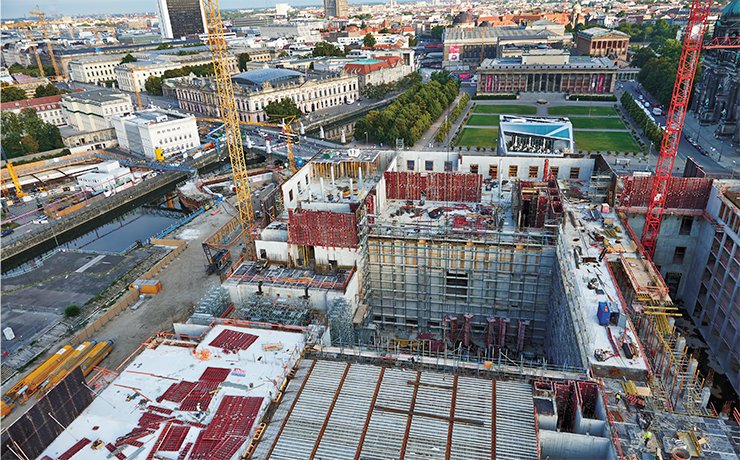
The project of reconstructing the Berlin Palace is to some degree controversial. The main argument in its favour was the consideration that the rebuilt Palace would close a gap in the historical planning of Berlin’s old centre. Thus, the historical ensemble would be reconstructed in its original context, and become comprehensible as a whole. If one looks at the aerial photographs dating from the time before the destruction of the Palace, it becomes apparent that the big street axes that transect the centre of Berlin are virtually oriented towards the corners of the Palace building. It means that the Palace had a clearly formative character in the centre of Berlin. Actually, the centre was laid out from the Palace and not vice versa.
The Berlin Palace was damaged as a result of hostilities during World War II. However, immediately after the war it was again used as a museum, and various academic institutions had offices in the building. Then the government of the GDR gave orders to blast and pull it down in 1950/51, which was an ideologically motivated act since the Palace was viewed as a symbol of militarism and feudalism that had to be completely erased. Back then there were massive but unsuccessful protests against this barbaric act of destruction: after all, the Berlin Palace was one of the most important Baroque buildings of northern Germany.
In a few years, the gap in the urban planning of Berlin’s centre will be closed, and the historical façade of the Berlin Palace will once again blend in harmoniously with the environment which is characterized by other historical buildings. As the most ancient core of the city of Berlin is located in the Palace area, the start of the reconstruction work was preceded by excavations that had taken several years. The residence of the Brandenburg Electors stood on this site as early as in the fifteenth century. Unfortunately, none of the remains of the older buildings found on the site were documented, neither when the Palace was blasted nor when the Palace of the Republic was built in the 1970s. As a result, all older historical traces were destroyed without any documentation when the Palace of the Republic was built. However, in the western part of the area there still exist parts of the basement of the former palace structure; they surround the Eosanderhof in the north, west, and south. Some of the excavated parts will become integrated into the rebuilt Palace.
In fact, the future Humboldt-Forum in the reconstructed Berlin Palace will be in the centre of a veritable future-oriented topography of art and culture, scholarship and education: to the north of the Museum Island, to the west of the German History Museum, of the main building of Humboldt University, and of the National Library on Unter den Linden, as well as to the southeast of the main building of the Berlin Public Library. The Humboldt-Forum will mainly exhibit the non-European collections of the Berlin National Museums of the Prussian Cultural Heritage Foundation. In addition, there will be exhibition space for Humboldt University and for the city of Berlin. The historical legitimacy of accommodating these institutions in the Palace derives from the Art Chamber (Kunstkammer), which once was located in the Palace and which had the museum collections that later were moved to Museum Island. It was the Palace where the first public library came into being; the Art Chamber’s collections related to the history of science, which today are part of Humboldt University, have their origin in the Palace as well.
The so-called non-European collections of the Berlin National Museums, Prussian Cultural Heritage Foundation, are kept in the Ethnological Museum and in the Museum of Asian Art. To some extent, these collections are associated with Germany’s colonial history. However, much more important for their emergence and development were Prussian-German scientific expeditions. Georg Forster, for example, accompanied James Cook in the Pacific Ocean voyage and laid the foundation of the Pacific collection of the Ethnological Museum. Alexander von Humboldt brought the first objects from Mesoamerica to Berlin. Von Hoffmannsegg was one of the collectors who contributed to the abundant collections of Amazonian cultures, and Hermann Schlagintweit travelled to Mongolia and Tibet. Many others might be mentioned in this context as well. Hence, it was Prussian scholars and explorers who in the course of the nineteenth century made an essential contribution to the compilation of unique worldwide collections in Berlin.
In the Humboldt-Forum Palace
The inner area of the Humboldt-Forum will be divided into various sections. On the ground floor there will be a large event centre (the so-called Agora). The Humboldt-Forum will also include sections for temporary exhibitions, multi-functional rooms, and auditoriums for music performances, theatre and cinema shows, panel discussions, and academic events. All the spaces are intended to spawn intense activities that create a bridge, so to speak, between historical heritage and the present and future issues. In addition, they will provide a vivid experience of the diversity of cultural expression. Moreover, the ground floor will offer practical facilities such as museum shops, cafés, and restaurants, particularly in its eastern part close to Schlüterhof.
After entering through the main entrance beneath Portal III under the cupola, visitors will get into the Entrance Hall. In its immediate surroundings, special exhibition spaces will be grouped in the south, while multi-functional halls and auditoriums will be in the north. The large entrance hall is intended to aid visitors with quick orientation; it is from the central entrance area that the various parts of the Humboldt-Forum can be accessed and explored. In addition, the central hall, with up to 2,000 seats, can be used for major events.
In the south-eastern part of the ground floor there is the Museum of the History of the Site, where through the so-called archaeological window the visitors will have a look at the remains of the original basement, which, in a way, lend legitimacy to the entire rebuilding project. On the ground floor, above the “archaeological window,” the history of the site is presented, beginning with the history of the Palace construction, continuing with the Palace of the Republic, and concluding with the rebuilding of the Palace as the Humboldt-Forum. The Schlüterhof, located in the eastern part of the Palace, will not be covered with a roof. In the north, east, and south it will regain its former look thanks to the reconstruction of the so-called Schlüter façades. It will lend itself as a location for major open-air events on specific occasions.
The first floor will also house the so-called Workshops of Knowledge, i.e. specialized libraries and research archives of the non-European collections of the Berlin National Museums, Prussian Cultural Heritage Foundation, which will be accessible to the general public. In addition, to the east of the Schlüterhof there will be the Berlin Public Library, where a particular emphasis will be laid on the theme ‘World of Language’: a modern library of languages including a media library and sections for children and adolescents. In the northwest, there will be rooms designed for Humboldt University. There, the focus will be on the Humboldt Laboratory, a space for temporary exhibitions that will give the visitors a clear idea of the work and functions as well as of the limits and contradictions of modern scientific research. The presentation of large objects from the Pacific, such as boats and meeting houses, will begin in the two rooms immediately to the north and south of the reduced Eosanderhof. That way, a direct vertical connection is established between the special exhibit spaces of the ground floor via these two areas and the exhibition levels on the second and third floors.
The second and third floors are exclusively reserved for the presentation of the non-European collections of the Berlin National Museums, Prussian Cultural Heritage Foundation. People will be invited to a “journey around the world,” admiring the immense collections of the Ethnological Museum and of the Museum of Asian Art, both of which are among the most important of their kind worldwide. The collections will be exhibited in an entirely new manner which will help the visitors not only to “hear” the stories told by the objects, but also to make people understand the structure of past and foreign cultures. As becomes evident from the excellent collection of boats from the Pacific, navigation was of particular importance in Oceania. This needs to be illustrated accordingly by the arrangement of the objects: What was the role of navigation in the rituals, in the mindscape, in the world of islands? How did the settlement of the region take place? What were Oceania’s relations with Southeast Asia on the one hand, and with South America on the other?
Almost every ethnographical collection in the world includes masks from Africa. Although these masks are not works of art, we perceive them as such today. A modern, up-to-date exhibition has to take this into account, and inform the visitors about what these ‘works of art’ reveal about the structure of a respective culture, i.e. what they contribute to traditional beliefs, issues of political representation, etc. A king’s throne from Cameroon was bestowed as a gift on the German emperor Wilhelm II, who immediately passed it on to what was then the Ethnographical Museum. Ironically, this diplomatic gift will soon move to the place for which it was originally destined – the Berlin Palace.
When organizing exhibitions, it is important to consider not only the German or European outlook on the world, but also a different perspective. Since the time when Europeans first came into contact with peoples from other continents, there have appeared numerous testimonies of how Europe was perceived by representatives of African, Asian, or American cultures. The Humboldt-Forum needs to tell these stories, too. Europe ceased to be the centre of the interpretation of the world long ago. Consequently, exhibitions should reflect people’s outlook on their own culture and on the culture of Europeans.
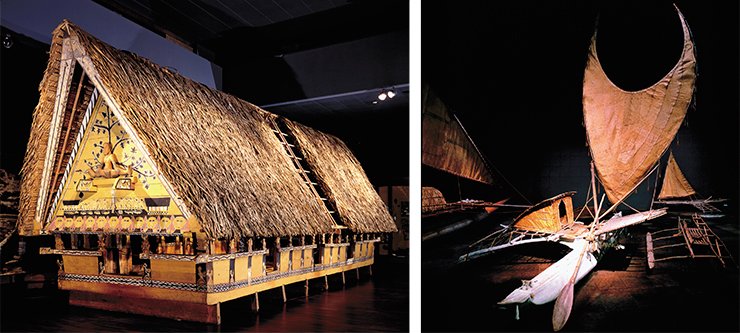
The collection of the Ethnological Museum includes a whole range of objects from Central and West African countries, whose people were forcibly moved to South and Middle America as a result of slave trade. Whole ethnic groups were brought to the New World, bringing along their own rituals, beliefs, and artistic concepts. They merged with the autochthonous cultures of Latin America; in addition, they absorbed elements of Catholicism and of European art. This amalgam—the fusion of diverse cultural currents—is one of the most fascinating phenomena of the modern age; it can be addressed in many ways using the collections of the Ethnological Museum. Another particular focus will be on the collections from Mesoamerica, which are among the largest outside Mesoamerica. They make it possible to trace closely the development of the Maya and Aztecs, who built—among others—the first megacities in the New World.
The art of Asia is mostly of a religious nature, and this is particularly true of Buddhism. In this respect, the Museum of Asian Art has a very well-stocked collection that will be fully presented in the Humboldt-Forum. In the case of Asia, too, the presentation of development of culture begins with archaeological finds dating from early times, such as bronze products of the Shang dynasty and works of art of Gandhara culture.
The Buddhist wall paintings in the caves along the Silk Road are of special importance. The wall paintings in the Turfan Basin area were studied by several German expeditions from Berlin at the beginning of the 20th century. They were brought to Berlin, and now it is possible to reconstruct the caves in their original form with the original arrangement of the paintings. At that time Central Asia was one of the earliest ‘globalized’ regions in the world, having traces of religions, languages and art of different cultures, both western and eastern. The exhibition of Asian art is concluded with paper pictures, folding screens, and hanging scrolls (dating back to the 18th and 19th centuries) from China, Japan, and Korea.
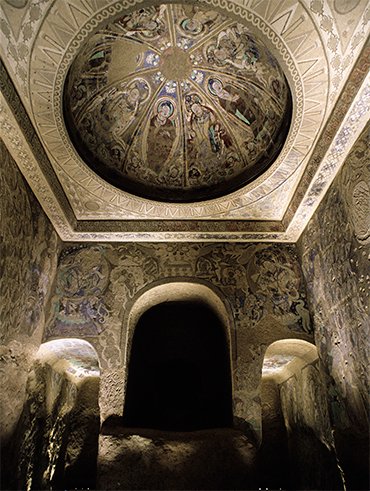
It will be particularly important to intersperse and enliven the exhibition floors in the Humboldt-Forum with zones that will allow for various activities originating from respective regions of the world. Now when the Humboldt-Forum is being designed, it is necessary to think about how to deal with contemporaneity. This includes dialogue between contemporary artists and selected works of art. We have recently practiced this, using an 18th-century Chinese imperial throne as a point of departure: various artists created works of art that showed their ways of digesting the object.
The Humboldt-Forum will be not only a museum, but also a place for manifold encounters with the arts and cultures of the world. There will be a focus on special programs for children and adolescents who will be introduced to other cultures of the world. Particularly in a city like Berlin, which is becoming increasingly multicultural and multiethnic, it is of crucial importance to give people from other cultural spheres a cultural home and to share things from their regions of origin with them. Hopefully, it will help people to establish ties with the Humboldt-Forum as a site of their cultures and histories.
In the 19th century the Museum Island was perceived as the centre of European art and culture that evolved from the Middle East. The Humboldt-Forum as a centre of art and culture of Africa, Asia, Australia, Oceania, and the Americas is a cultural project in the early 21st century. The Museum Island and Humboldt-Forum together are an outstanding artistic and cultural centre of the world.
These days, the construction activities in the Museum Island are far from completed with only half of the master-plan implemented so far. However, when the Humboldt-Forum, which is located in the reconstructed Berlin Palace, opens its doors to visitors in 2019, the ambitious project of this century, which was conceived 150 years ago, will become a reality.


